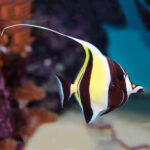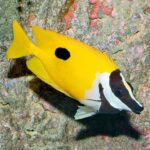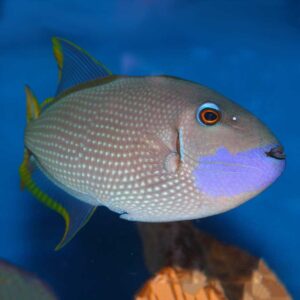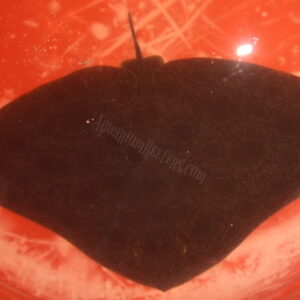Description
The Raccoon Butterfly Lunula, also known as the Lunula Butterflyfish, displays a stunning colouration and unique markings. It has a maximum size of around 8 inches (20 cm). The body is round and laterally compressed, with a dorsal fin that extends into a long filament. The base colour is yellow, and it is adorned with striking black and white markings. The face features a prominent black mask that resembles that of a raccoon, giving it its common name.
Natural Habitat:
The Raccoon Butterfly, Chaetodon lunula, inhabits coral reefs and rocky areas in the Indo-Pacific region. It is commonly found in clear waters with moderate to strong currents. Its natural habitat is characterized by vibrant coral formations, various species of marine plants, and a diverse range of reef-dwelling organisms. These fish seek shelter among coral branches and crevices, making use of the intricate structures for protection and foraging.
Keeping Raccoon Butterfly Lunula, Healthy:
The Raccoon Butterfly Lunula requires moderate care and attention to ensure its well-being. It has a moderate care level but can be a bit delicate, requiring specific conditions and attentive care. Maintaining stable water parameters, such as a temperature range of 75°F to 82°F (24°C to 28°C) and a pH range of 8.1 to 8.4, is crucial. Good water quality, proper filtration, and regular water changes are essential for their health.
Special Requirements and Feeding:
Raccoon Butterflyfish have a specialized diet consisting of marine-based foods. They should be offered a varied mix of meaty preparations, small crustaceans, and quality marine flakes. It is recommended to feed them small amounts multiple times a day to ensure they receive adequate nutrition. Live or frozen foods can be included to provide variety and stimulate natural feeding behaviours.
How Many Should I Keep?
It is best to keep Raccoon Butterfly Lunula singly or in mated pairs due to their territorial nature. Keeping multiple individuals in a small tank can lead to aggression and stress. Providing ample swimming space and hiding spots will help create a suitable environment for a single fish or a pair.
Lighting Preference:
Raccoon Butterflyfish can adapt to a range of lighting conditions. However, moderate to high lighting levels are preferred, as they help enhance the fish’s vibrant colours and showcase its unique patterns. Proper lighting also benefits the growth and health of any live corals or plants present in the aquarium.
Suitable Tank Mates:
Raccoon Butterfly Lunula are generally peaceful but may exhibit territorial behaviour. They can coexist with other peaceful species, such as tangs, angelfish, and other non-aggressive reef fish. However, caution should be exercised when choosing tank mates, as some species may be more aggressive and may intimidate or harass the butterflyfish.
Reproduction in the Wild:
In the wild, Raccoon Butterflyfish engage in elaborate courtship displays before spawning. Pairs perform synchronized swimming patterns, fin flaring, and other behaviours to establish their bond. Once courtship is successful, they release eggs into the water column, where fertilization occurs externally. The eggs are then left to drift with the currents until they hatch into larvae, eventually settling into the reef as juveniles.
Breeding Chaetodon lunula:
Breeding Raccoon Butterfly Lunula in captivity can be challenging and has limited success. Replicating natural spawning conditions and employing techniques like hormone injections or specialized diets may be attempted. However, the complexities of their reproductive behaviour and larval rearing make successful captive breeding a rare occurrence.
Sexual Dimorphism:
There is minimal sexual dimorphism in Raccoon Butterflyfish. Both males and females display similar colouration and markings, making it difficult to distinguish between the sexes based on visual appearance alone.
Distribution:
The Raccoon Butterfly Lunula is naturally distributed throughout the Indo-Pacific region, including the Red Sea, East Africa, and the Hawaiian Islands. It can be found in various countries, including Indonesia, Australia, the Maldives, and the Philippines. While captive-bred specimens may be available, the original wild fish primarily originate from these areas.
Summary:
The Raccoon Butterflyfish, scientifically known as Chaetodon lunula, is a visually captivating fish with vibrant colouration and distinct markings. With a maximum size of around 8 inches (20 cm), it thrives in moderate to strong currents within coral reefs and rocky areas of the Indo-Pacific region. Although they require specific care and attention due to their delicate nature, providing stable water parameters, a suitable diet, and compatible tank mates can contribute to their overall well-being. While captive breeding is challenging, observing their natural behaviours in the wild and appreciating their unique features make the Raccoon Butterflyfish a prized addition to marine aquariums.
The Fish pictured here are representative only and the livestock you receive may vary in pattern, coloration, and shape.









Reviews
There are no reviews yet.